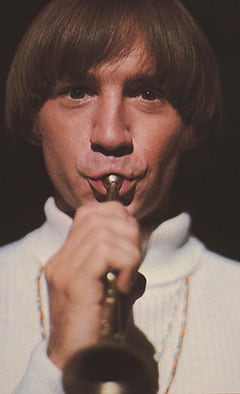
It’s been noted that former Clash manager Bernie Rhodes’s favorite song during the advent of punk was “(Theme From) The Monkees.” “This is the part I like best,” he’d claim, singing along to “We’re the young generation, and we’ve got something to say.”
This anecdote tells us two things: 1.) Bernie Rhodes was a putz. Which needn’t bother us here. 2.) The Monkees’ influence wasn’t as ephemeral as some of us may have supposed. A surprise?
After all, even with the mist of time lending a pinkish hue to our memories, the Monkees were corporate product. They were four actors hired by TV producers to play patty-cake with pubescent kids too young to worry about the war in Vietnam, but still dreaming about a riot of their own.
The Monkees’ TV show almost had to get it wrong. The producers wanted a Beatles/A Hard Day’s Night clone. NBC and music mogul Don Kirshner wanted four boys who didn’t answer back. The producers got the pin-up boys, Kirshner got the Tin Pan Alley tunesmiths, and together they got the right look. The Monkees looked the part (all polo necks and tambourines), and they kept the teenyboppers hearts going boom-boom-boom. However, they positioned themselves well away from the cutting edge. If the Beatles now wanted to turn you on, the Monkees still wanted to hold your hand. And together they reaped the rewards—until Mike Nesmith gave Kirshner the old heave-ho. Even the “hip” producers hadn’t figured on the politics.
Of course, The Monkees—the story of four rock musicians one step ahead of an eviction notice—originally had three basic plots: Davy falls in love, the Monkees fight big business on behalf of the small time entrepreneur, and the Monkees fight (presumably communist) spies and return the secret documents to our government.
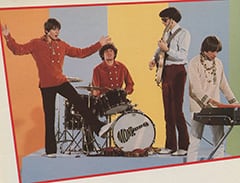
The very idea of The Monkees was palliative: take once a week and call after the revolution. But the weird thing is they were both working within society and because of their “dippy” and gentle natures—sneered at by society. Authority figures on the show were cut-out caricatures whom they prevailed over by luck as often as smarts. The Monkees had no visible parental influences, but because of this, there was no need to seriously consider the dimensions behind age discrimination. The last thing in the world NBC wanted to do was offend their sponsors.
The show, in step with changes within the band, eventually became radicalized because it was forced to. The question wasn’t of content but of form—and the result of their star/fan relationship. The Monkees suddenly found themselves a part of society that their audience found attractive, romantic, honest, idealistic—and thoroughly bewildering.
I’m talking demographics here. I’m talking 8-to-15 year olds who found themselves on the sidelines of a society in a state of confusion, apprehension and upheaval. The Monkees became a continuum of this social upheaval who, through their harmlessness, lessened children’s fears of dislocation, while giving their audience a clear idea of some of the things at stake (i.e., personal freedom, moral capitalism and alternative communities).
Of course, none of this matters much to the people watching The Monkees for the first time today. The current fans, raised on MTV, are responding mainly to a prime time TV director’s re-thinking of Richard Lester’s innovative Beatles movies as perfected with Help! The program used scatter-shots, scatalogical dialogue (Moonlighting is a spiritual descendent), madcap Marx Brothers-inspired antics and wiseacre one-liners. When the on-screen action was set to music, the Monkees either lip-synched or acted out the song. In other words: the birth of rock videos—an art the Monkees perfected and nobody has really improved on that much.
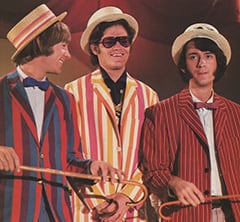
And what were the Pre-fab Four doing as they were making history? Like most of their friends and colleagues, they were allegedly taking drugs, playing with groupies, hanging out with the trendsetters, learning their craft, discussing realpolitik, protesting the war. That kinda stuff.
You see, Don Kirshner and crew made a miscalculation. They might have well hired puppets, but they got people—people who suddenly found themselves with an immense amount of influence. It’s true the Monkees were formed after a huge casting call. It’s also true that Peter Tork was a professional musician, David Jones an accomplished actor (he’d appeared in the British soap, Coronation Street) and singer who’d played the Artful Dodger on Broadway in Oliver!, and Michael Nesmith was an excellent songwriter. Micky Dolenz had been a child TV star on Circus Boy, so he knew precisely what he was getting into. They were hired partially because they had chemistry together. But while they began life as a fabricated band, they surely didn’t end as one.
Today that would probably mean that they know Sean and Madonna personally. In the second half of the ’60s, though, the implications were somewhat different. Being in one of the most popular rock bands in the world meant that you were artists with moral convictions and explicit responsibility. Popular music will always be the soundtrack to a decade, but in the ’60s, it was also instrumental in the making of the decade.
For the Monkees, that meant wrestling control of their careers. It meant singing anti-war anthems like “Zor And Zam.” It meant them thanking the musicians who’d helped them record, while noting that they’d played most of it themselves on the back of some of their later albums. It meant writing drippy hippie comments on the back of their great Pisces, Aquarius, Capricorn & Jones Ltd, album. And it meant sticking experimental psychedelic effects on their LPs.
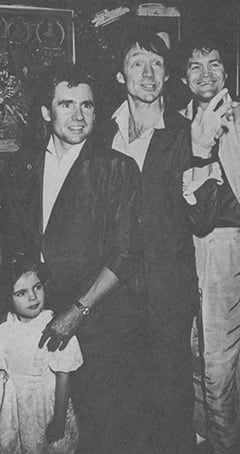
Unfortunately, it didn’t mean that the Monkees were always as commercial or creative as the writers who worked for them. But when you boil the Monkees down to their best stuff, they still sound fresh today. “I’m A Believer,” “Randy Scouse Git,” “Pleasant Valley Sunday,’ “A Little Bit Me, A Little Bit You,” “Look Out (Here Comes Tomorrow)”—name your own. Neil Diamond later recorded his own “I’m A Believer,” and it wasn’t half as good as the original. (I just saw the Feelies cover the song the other day, and it was very wonderful, indeed.) Live, the Sex Pistols used to perform an epochal cover of “(I’m Not Your) Steppin’ Stone.” And there was Bernie Rhodes…
The Monkees tours were maniacal extravaganzas with little girls doing the things little girls used to do at rock concerts. Still, Micky Dolenz took the opportunity to introduce them (when they weren’t fainting) to James Brown with a delirious tribute. And they also attempted to introduce the greatest guitarist who ever lived by having the Jimi Hendrix Experience open for them. A mismatch made in heaven! It’s worth noting that those were the days of civil rights marches and a more openly racist time than even today. It was rare for a white band to have a black man on the same bill.
But the Monkees’ bravest act—and biggest failure—came with Bob Rafelson’s Head. The motion picture was a surreal, psychedelic, almost dadaist collage of sound and vision. The film bemused almost everyone, and certainly confused their fans. The Monkees in the trenches of Vietnam? What’s that got to do with a pre-teen exploitation movies? Like the Mop Tops before them, the Monkees had outgrown their audience.
And if the Monkees were respected in England (Paul McCartney: “I’m sure the Monkees are going to live up to things many people didn’t expect”; George Harrison: “The Monkees are still finding out who they are and they seem to be improving as performers each time I see them. When they get it all sorted out, they may be the greatest”; John Lennon: “They’ve got their own scene and I won’t send them down for it. You try a weekly television show, and see if you can manage one half as good!”), hip Yanks—particularly the newly born rock critics—loathed them with a passion.
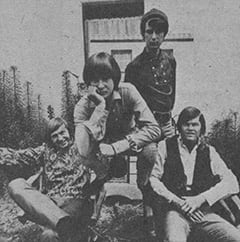
Unfortunately, the Monkees—whom I believe were very good—weren’t good enough. They disappeared in a battering of a flop movie, cancelled TV show and poor LPs that failed to dent the charts. They disappeared as quickly and completely as the decade that spawned them.
And now it’s 20 years later. The show is in reruns, the albums are on the charts and the Monkees are on a sold-out tour. Rolling Stone is still slagging them off, and my editor is on the phone asking if I want to write a “social, political, cultural” piece for a Monkees special. The social and political question is moot. The Big Chillers pledging allegiance to their past are well aware of what happened. The new fans don’t care. If they want social conscience, they’ll listen to U2, thank you. The Monkees’ politics are as relevant as ever. It’s the Monkees’ position today that’s disjointed. We don’t, even if we should, discuss such subjects as politics in the pure entertainment fields in 1986, and watching the Monkees do so would be anachronistic. Imagine Duran Duran making a video condemning American intervention in Nicaragua, and you’ll get some idea of what it would be like.
Culturally, the Monkees are set. Who cares who played on what song in a world where the producer chooses the “right sound” for the most popular groups? Who cares who wrote what when it was the Monkees’ effervescent spirit and sweetness that makes them as special today as when the songs were recorded?
That spirit is why they weren’t as ephemeral as we’ve been led to believe. Kindness and caring never go out of style. Or at least when they do, we’ll get the Monkees back for another reunion.



